The importance of Health and Safety in all phases of construction





September/October 2023
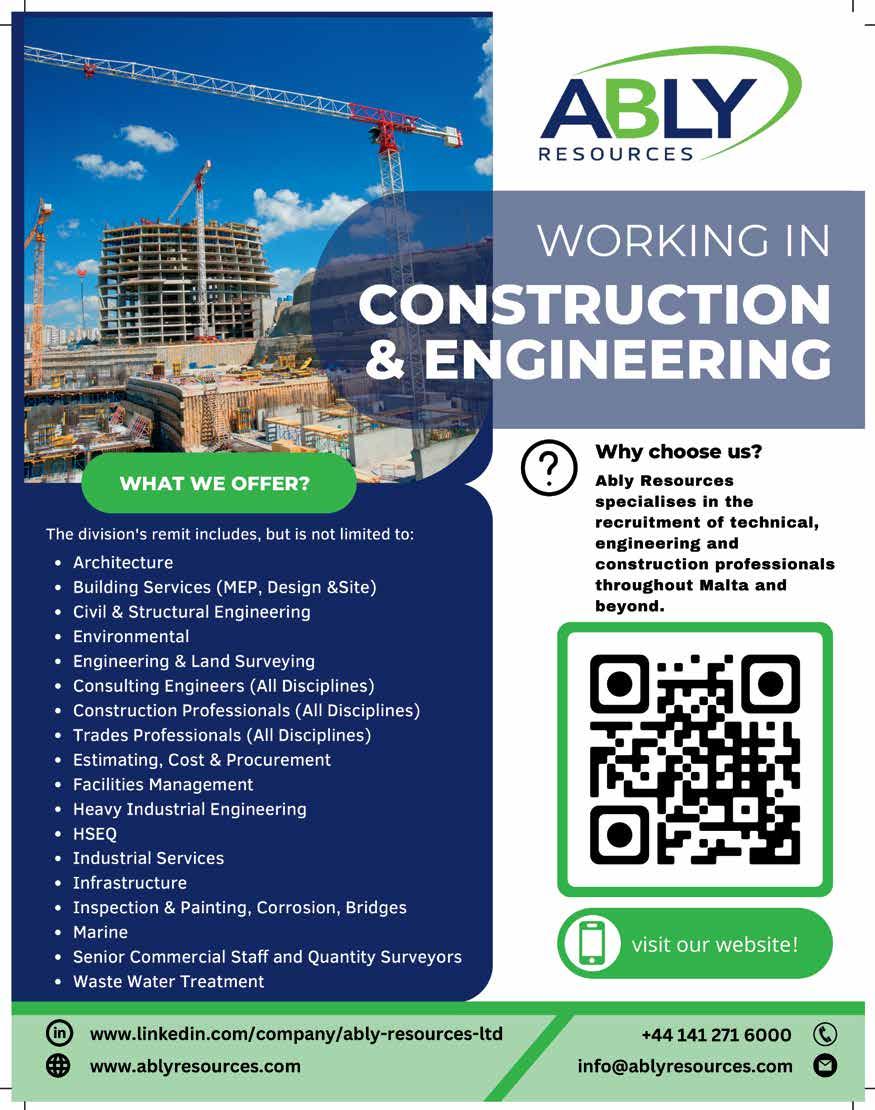
Publications and Financial Officer: Fabrizio Gerada MCIOB

Welcome to another edition of Managing Construction, where in this issue, we prioritise the crucial topic of health and safety procedures, recognising them as the bedrock of any construction site.
While it's essential to advocate for improved legislation and enforcement, the impetus for change begins with us. We must cultivate a strong foundation within our teams, centered on education. This education should encompass not only the ethical and procedural aspects but also the profound consequences of disregarding these practices.
It is imperative to extend this emphasis to all levels of our organisations, addressing not only the health implications but also the potential traumas experienced by families, the financial repercussions, operational inefficiencies, and more.
These considerations should permeate every stage of the project life cycle, with a particular focus on the design stage. During this phase, management has the time and opportunity to plan and evaluate safety measures. Modern tools like Building Information Modeling (BIM) can aid in this process, aligning with values such as Environmental, Social, and Governance (ESG), which we promote within our chamber.
As always, we urge our readers and members to remain at the forefront of innovation and best practices, as these are the keys to solving complex modern challenges.
Who We Are
The Chamber is the voice of the construction managers at the various levels operating in Malta and beyond. We promote and expect, high standards in, quality, ethics, integrity and to be at the forefront of innovation of the local built environment. Through our input we strive to influence policies and regulations that impact the industry and their impact on the common good.
Mission Statement
To promote science and technological advancement in the process of building and construction for the public benefit.
To be at the forefront of public education, encouraging research and sharing the outcome from this research.
To make sure that advancement in the built technology is aimed at improving the quality of life of the public in general.
To enhance professionalism, encourage innovation and raise quality in construction management.

To promote high standards and professional ethics in building and construction practices.
To promote the highest levels of integrity in every decision that we take that affect others.
To respect all those affected by our decisions
TO BE THE DRIVER OF A CULTURAL AWARENESS CAMPAIGN STRIVING
Editorial enquiries: info@mccm.org.mt
Advertising: info@mccm.org.mt
FOR PROFESSIONALISM IN THE CONSTRUCTION INDUSTRY.
Editorial
3
Photo: HSBC Hub Refurbishment Qormi



Contents SEPTEMBER / OCTOBER 2023 4 For instant updates follow us: Twitter:@mccm Facebook: MCCM Website: mccm.org.mt Email: info@mccm.org.mt LinkedIn:maltachamberofconstructionmanagement 03 | Editorial 04 | Contents 06 | Message from: The President and the CIOB CEO 08 | Planning and Scheduling of Construction Projects 10 | Legal 14 | Suicide The Silent Killer in Construction 16 | Communicating on the way to successful project execution 17 | Principles of Building Maintenance 18 | The development of BIM Standards 21 | Health and Safety 24 | The Balance of Sustainable adaptation and Conservation: The Phoenicia Hotel 28 | Document F Consultation 29 | Interior Design 30 | A Net Zero Economy 31 | ESG and The Role of Authorities in the Construction Industry Sector 36 | Dealing with Variations in Construction Projects 22 | Building Trust 12 - 13 | Unlocking the Power of Communities of Practice 32 | Sustainability and Building Material
40


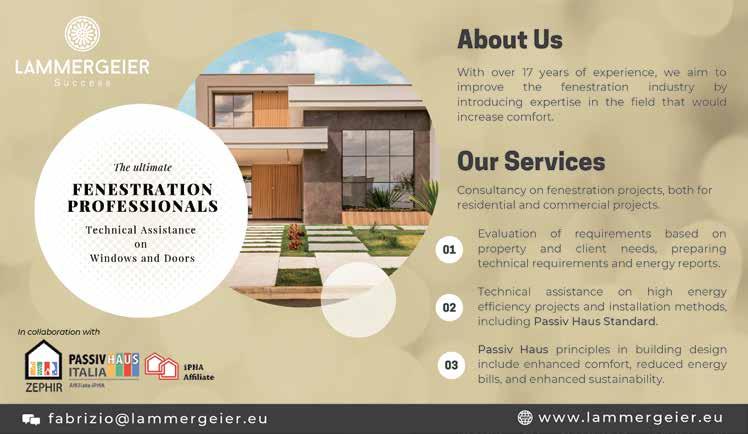
42

5
| A vision for Industrial Heritage in Malta
38
| The Eternal Plague of Adding Water to Concrete on Site
| Different Types of Slab in Construction
| Strip Footing and Pad Foundation
| Courses
| Opinions
| Events 34 47 | Educations and Developments CPDS
44
46
48
50
Message from
THE PRESIDENT AND THE CIOB CEO
Welcome to the seventh edition of Managing Construction. Following the recent events in relation to the Corradino Tragedy and the eventual outcome of the magisterial enquiry, I felt it was our duty to dedicate this edition towards the importance of Health and Safety in the Construction Industry.
Unfortunately, although in Malta we have a set up that should be similar and on a par with all other EU members, the reality out there is totally different. Many people blame the authorities that they do not enforce enough and argue that not sufficient work is being done to boost the resources required by government agencies. Based on my personal experience working abroad, I think that this is an excuse. My colleagues and I, whilst managing projects, never expected some kind of “inspector’’ to come and tell us what we had to do in order to protect the wellbeing of all those involved in the project. Instead, we were given the appropriate training and ‘’brainwashed’’ to implement the training that we were given.
Once again, I would like to take this opportunity to highlight the importance of the legal recognition of the Construction Project Manager in all this scenario. Until projects in Malta are completely run by a professional whose main focus is the over all control of every aspect of the project’s lifecycle, I am afraid that the issue of H&S on construction projects and the lack of it will continue to linger on.
It is clear that this country is craving for the legal recognition of this professional. The Quintano Report accentuated this and if there were any doubts, results of the Corradino Tragedy Enquiry provided a further confirmation.
For how long will this country is going to remain ‘’blind’’ and not follow the experiences gained by other developed countries?
JOIN US
BENEFITS
Instil professionalism, innovation and quality - Continuing Professional Development Opportunies - Affiliation with the Chartered Insitute of Building Preparation for the Cosntruction Project Manager Warrant

An active community willing to improve the industry Built around the busy schedules of professionals www.mccm.org.mt


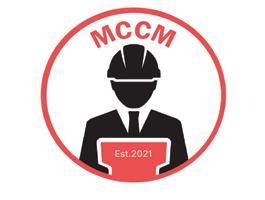
I am pleased to see this issue of the MCCM magazine focus on health, safety and quality in construction. MCCM members and CIOB members based in Malta can be at the forefront of embedding a culture of quality and safety in this important industry.
This is still a live issue in the UK and elsewhere and is something we maintain a focus on. In fact, the CIOB’s latest corporate plan has three headline themes: sustainability, the skills gap and quality and safety. The plan states that the safety of the built environment should be so fundamental it can be taken for granted - but we all know that, sadly, this is not always the case.
We also all know that good quality buildings and infrastructure promote health and wellbeing and deliver social, cultural, environmental and economic benefits.
CIOB has had quality and safety as a priority with a Quality Commission, led by some of our Past Presidents, set up back in 2017. This has resulted in a lot of work with government, other professional bodies and members across the industry. We have also produced a number of resources to share learnings and best practice. But we know there is still more to do.


For those who would like to explore our resources on quality in construction, many of which are free, head to the CIOB Academy website: https://www.ciobacademy.org
Our corporate plan commits CIOB to helping drive a culture change to ensure quality and building safety are never sacrificed for profit. I will watch with interest the progress our partners in Malta can make in helping to improve the safety culture in our industry.

6
MALTA CHAMBER OF CONSTRUCTION MANAGEMENT

Planning and Scheduling of Construction Projects
 Cihan Sahin
Cihan Sahin
Time is one of the items of project management triangle. An effective time management required both on paper and construction site to perform a successful project management. In this regard, some innovative methods with support of technology are being preferred by professionals in construction industry. However, fundamentals of planning and scheduling in construction projects are to be considered with acquired experience in the construction projects. Otherwise, these studies may be finalized with a negative impact.
Planning:
In this phase, work breakdown structures (WBS) and project activities should be determined. Number of activities can be shaped in accordance with project contract requirements. A quantified resource plans as manpower, machinery and material should be prepared in line with project requirements and company assets. During resource planning, procurement and supply periods should be always considered because these periods sometimes take significant duration to obtain. With support of the experienced professionals of the organization, activities should be assessed in term of duration and sequence.
Scheduling:
solutions instead of specific software may be preferred. Appropriate software should be chosen in accordance with projects contract requirements, project budget and company infrastructure. Time calendar should be adjusted and related duration calculations for project completion should be performed. In addition, critical path of the project should be analysed to take related precautions in order not to cause a delay in the project.
Monitoring:
A baseline schedule is formed and monitoring of the project is done over baseline schedule. Actual progress of the project is compared with baseline schedule and necessary assessments are performed by project professionals. There may be several differences between plan and actual due to the real construction site conditions. Therefore, schedule should be routinely updated or revise if necessary to make a better time management.
 Mr. Ed Howell
Mr. Ed Howell
After planning phase, the project should be scheduled by utilizing some specific scheduling software such us Primavera, Microsoft Project, Asta Powerproject, Tilos etc. In some organization, time management in-house
8
Table 1) Main Principals of Planning and Scheduling
To sum up, an effective time management is start with a realistic plan. Know-how factor is also inevitable true for the planning and scheduling of construction projects to reach the intended positive results because resources for construction activities, works sequences, duration of activities have to be foreseen as much accurate as possible.


9
Figure 1) Sample Scheduling by Primavera P6 Software
Court Report
Dr. Ivan Mifsud LLD PHD

Importance of filling in insurance proposals correctly


The Court of Appeal presided by Mr Justice Lawrence Mintoff on 21st April 2023 (ref 48/2022 LM) overturned a ruling of the Financial Services Arbiter who had dismissed a complaint lodged by an insured person made a claim after his boat sank, which claim was refused. The insurance company accused him of a number of breaches, including that he had not informed them that he had been convicted for obtaining his nautical licence by bribing an official at the transport authority. The proposer (i.e. the person who applied for and took out an insurance policy) had instead informed them that he had a conviction for not being in possession of a valid nautical licence. The issue of ‘utmost good faith’ thus arose, this being the principle that when one fills in an insurance proposal form, one cannot hide important details from the insuring entity.
The Court of Appeal agreed with the Arbiter that this particular aspect of insurance law is not codified in Malta and therefore we rely on the interpretation given in English law. It was further explained that in England, common law i.e. judge-made law, was replaced by a written law, and with it the interpretation of what amounts to ‘utmost good faith’ had been modified, from an absolute obligation on the proposer to reveal to the insurance company not only all that one knows but also all that one should have known would be of relevance to the insurance company, to one in which the proposer is only expected to not hide important information, to take reasonable care to reveal all important
held that it was up to the insurance company to investigate the information which it had received, but had not done so,
10 Legal
Looking for a Construction Project Manager or a Site Manager? Reach out to our chamber and we will help you find the right professional for the job! E: info@mccm.org.mt W: www.mccm.org.mt T: +356 7711 6778

Unlocking the Power of Communities of Practice
 Andrei Cachia MCIOB
Andrei Cachia MCIOB

Adaptation to Industry Changes
In the ever-evolving world of construction, effective project management is the key to successful outcomes. Whether it's the recent construction projects we are experiencing in Malta that of high-rise buildings, an expansive residential complex or a modest home, a well-coordinated and controlled approach is essential. The importance of Communities of Practice (CoPs) in the field of construction cannot be overstated, especially when Malta is trying to raise the bar of the Construction Industry in all aspects. The Malta Chamber of Construction Managers (MCCM) has laid down a code of ethics and professional conduct that underscores the significance of effective ethics and professional conduct that underlines the significance of effective Construction Project Management (CPM). One of the key principles in this code is the assurance that the Client will ascertain the management of highly skilled processes that facilitates planning, coordination and control of a construction project from inception to completion. This statement resonates profoundly with the fundamental role of CoPs that MCCM has embarked to organise to its members, including the general public.
Continuous Learning
Construction Project Managers play a pivotal role in ensuring that projects are executed smoothly from start to
finish and to the required standards/expected results. MCCM advocates that to excel in this role, CPMs should continually update their knowledge and skills through a myriad of different paths. CoPs provide an avenue for ongoing professional development, enabling us professionals to stay in line with the evolving project management methodologies and technologies. Ultimately, one would enjoy results of effective planning, coordination and project control to the highest standards.
Problem Solving and Collaboration
Construction projects are rife with challenges, ranging from unforeseen obstacles to changes in project scope. CoPs empower Construction Project Managers to collaborate with their peers, drawing from collective experiences to find innovative solutions to these challenges. Effective

12
problem-solving and collaboration are essential for maintaining control over a project's trajectory and ensuring its successful completion.
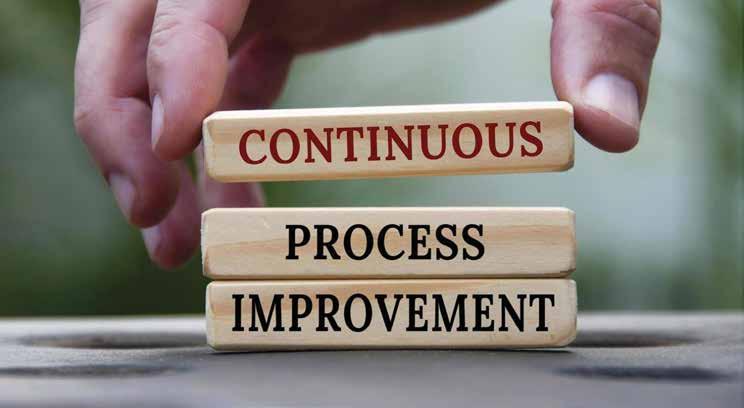
Journalist Daniel Ellul reported that “Construction is Malta's most dangerous industry” and as a result, records show that “between 2018 and 2022, 29 workers died on construction sites.” (Daniel Ellul, 16th July 2023, TOM). This is of great concern. At the same time, Malta is in a state of evolution; A recent positive approach being implemented by the government within the construction industry, is the introduction for the licencing of contractor’s regime that will regulate the demolition, excavation and construction sector. Can this be considered as one of the answers to improve quality and reduce incidents within the sector?
Furthermore, the government has also pledged on a number of successive years to “push forward legislation which will provide for the role of a Construction Project Manager” to ensure professionalism (budget speech 2022). One ought to ask, is this going to materialise? How long will construction projects going to continue being developed with no roles such as the “project manager to bring everything together” (Perit David Xuereb - public enquiry - Aug ’23 - TOM)?
How can CoPs help to address the above:
"The standards seen abroad are not yet in Malta." (Times of Malta – Aug ‘23). This is where CoPs can help; CoPs within the construction industry act as hubs where professionals, including CPMs, come together to share
their insights, experiences and best practices. The idea of organising these events was to provide a platform for individuals to learn from one another, keeping up with the latest industry trends and innovations. This knowledge sharing and discussions that develop during these sessions, are vital for the effective planning, coordination and control of construction projects, ultimately reassuring better management of construction projects.
To date MCCM has initiated these events which started from this year organised sessions through the Environment Resource Authority (ERA) - an important regulating body in Malta - to better equip us Construction Projects Managers, mainly during the permitting procedures concerning environmental permitting. In addition, another important CoP session was set up discussing Contract Management - a trait that a Construction Project Manager carries out on every project. Plans are underway for more sessions to be held which we strongly believe that they will leverage the community’s collective knowledge to adapt to the above mentioned changes seamlessly, which is crucial to maintain control over a project ultimately resulting in successful project outcomes. Through knowledge acquired, construction project managers are more likely to uphold the highest standards in planning, coordination, and control, thereby delivering projects that meet or exceed client expectations.
Suicide
THE SILENT KILLER IN CONSTRUCTION
Paul Netscher Construction Management Consultant and Writer

1,400 construction workers in the UK died by suicide between 2011 and 2017 – three times the national suicide rate. In America suicides amongst construction workers is also three times the national average, and nearly five times more construction workers die from suicide than work related accidents. These figures are probably underreported as they would exclude workers who are unemployed or retired. Also uncounted are those permanently disabled from failed suicides.

These are frightening statistics that few discuss. Safety is usually taken seriously in construction, yet suicides kill and permanently maim countless people every year.
Apart from the human toll, there is an economic cost, with an estimate that suicide deaths cost EU industries production losses of 9 billion Euros in 2015.
Why are suicide rates in construction so high?
There are few studies to the reasons for high rates of suicide, but my theories are:
1. Construction is a cyclical industry with times of little work. Many are employed for a particular project, then when their work is finished, they must find other work. It’s stressful knowing you’ll soon be out of work looking for another job, with a family and bills to pay. Construction workers can sit at home with no work, feeling worthless for months.
2. Being cyclical also puts pressure on management and owners who must continually look for new projects, wondering how they’ll pay wages, equipment instalments and office rentals. Submitting prices for projects can be stressful – is the price right, have you forgotten something? Then, the disappointment of losing one project after another.
“The stress of not being paid can lead to suicide.”
3. Daily we hear of clients not paying contractors, contractors not paying suppliers and subcontractors. Company owners have committed suicide when they’ve been unable to pay their employees because a client hasn’t paid them.
4. Frequently contractors become bankrupt, sometimes due to poor management, other times because of greed and thieving. Who suffers – workers and suppliers who don’t get paid. The stress of not being paid can lead to suicide.
5. Construction workers often work long hours and on weekends. They barely see their families, and when they do there are often arguments about the long work hours. A stressful home life can lead to divorce, despair and even suicide.
6. Construction workers can work away from home for long periods. Again, this leads to marriage problems. But time away from home leads to loneliness, time to think dark thoughts, and may end in drink and drugs.
7. Most construction jobs demand good health and a degree of physical strength. An injury, or even a sore back, can quickly end a career in construction. Fighting illness or pain daily to keep working can be a huge burden, leading to suicide.
“Construction is very much a man’s World. You have to be seen to be tough.”
8. Construction is very much a man’s World. You have to be seen to be tough. Any weakness is often pounced on by fellow workers. There is little sympathy.
9. Bullying is sometimes rife on some projects. Bullying and discrimination causes unhappiness and possibly leads to suicide.
10. Construction is frequently stressful with tight deadlines,
14
“Safety is usually taken seriously on construction projects, yet suicides kill and maim countless people every year.”
multiple problems, and unforgiving managers and clients. How can we rid construction of this killer?
“Awareness will cause us to do things differently – act in a more considerate way to our fellow workers.”

1. Awareness is important. Knowing about the problem means we are more likely to notice when someone’s mood changes. Awareness will cause us to do things differently –act in a more considerate way to fellow workers.
2. Clients can make construction less cyclical by scheduling projects when the construction industry isn’t busy. Construction costs also fall when there is less construction work around.
“Clients and contractors that don’t pay are killing the construction industry.”
3. Clients and contractors that don’t pay are killing the construction industry, but they are also literally responsible for deaths in the industry. If someone’s delivered the project to the required quality pay them on time. Why should some benefit unfairly from others?
4. Minimise long hours and overtime on your projects. Workers deserve to spend time with their families. They deserve to be home on weekends. Everyone needs a rest.
5. Those that must work far from home shouldn’t have to spend weeks away and then return for infrequent rushed breaks.
6. Bullying and discrimination should never be tolerated.
7. Managers and supervisors must be aware when things don’t seem right with a colleague or worker. Maybe they have mood swings, they are depressed. Take the time to talk to someone who is upset, quiet, moody, or not their
usual selves. Just being able to share problems with someone can help.
8. Ensure counselling and help is available to workers. Contact details of councillors should be displayed on projects. Talk about suicide prevention on your projects.
9. Staff projects adequately so people aren’t overworked. Provide training so people are competent. Supply the right equipment and tools.
10. Of course, equally important is to consider your own situations. Don’t take problems personally. Learn to reduce stress. Learn to talk about and share problems.
Good mental health is important.
Suicide is never a solution and invariably it results in untold problems and misery for those left behind.
“Don’t let the scourge of suicides stalk your construction project. It is preventable.”
Don’t let the scourge of suicides stalk your construction project. It is preventable.
We must make construction a better place to work. Treat people fairly and respectfully. Understand the human impacts of your decisions. Construction cannot afford to lose people – especially to suicide.
Ensure you take care of your health and the health of those working with you. Let’s look out for each other. Good mental health is as important as physical health. Good mental health will improve productivity on your construction project while decreasing the risk of suicides.
How will you improve the construction industry?
15
Communicating our way to successful project execution (Part
Catherine Hurley - AIS Malta

We’ve all been communicating since we were born, so there’s a tendency to think it should be natural. However when it comes to project execution, communication is a skill that is more often than not in need of development. Effective communication is the lifeblood of successful project execution. Here, over two articles, we can look at some ways to inform all
1 of 2)
culture. Now is the time to align outlooks and secure buy-in from all contractors, subcontractors and consultants, as well as the Client, on the importance of good site practices, housekeeping, efficient logistical arrangements and shared team pride in a quality outcome.

everyone's expectations. This sounds obvious, however this initial stage is often where the project starts to go wrong. On the other hand, this should be the time to get it right.
A design team needs to be able to convey the project particulars to the Client, who may or may not themselves have an understanding of technical matters. Spending time with the Client’s team to understand their culture, what they like and how they need to use the space is fundamental. The ability to be able to explain technical constraints, and propose options to overcome obstacles are equally important, and ensure that the client remains more consistently engaged during the scoping process and a much happier client upon completion. Technological tools such as 3D modelling make understanding conceptual design all the more easy, rather than relying upon assumption that every member of a Client team is capable of interpreting a suite of technical drawings.
At procurement stage, the priority is to ensure the project has been correctly detailed, the detail well communicated and understood, as well as accurately priced. But it’s also important to consider aligned expectations on quality, safety, health and environmental standards on site, site welfare set-up and the establishment of good on-site

Communicating the impact of change:
A team that has communicated effectively across the project lifespan benefits from an ability to mitigate against detrimentally impacting parallel workstreams as the result of obstacle or change. At AIS, we refer to this practice as the One AIS Approach. One AIS is a culture that we aim to embed across all of our projects. It is most obvious when multiple stakeholders work together in pursuit of solutions to change. The worst time to start communicating to stakeholders is when something bad happens. Maintaining open dialogue throughout the course of a project’s lifespan ensures a more efficient route to identifying the most effective solutions.
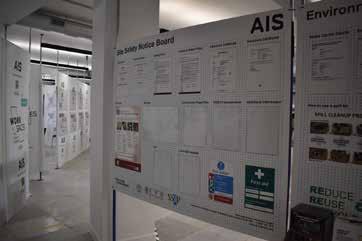
16
Principles of Building Maintenance
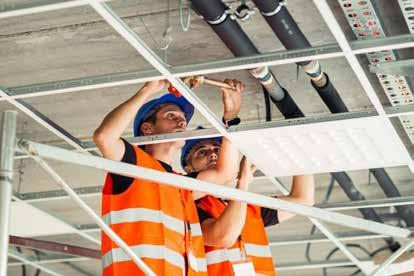
Facilities Management in Different Sectors
 Karl Attard
Karl Attard
The built environment expresses in physical form the complex social and economic factors which give structure and life to a community. The condition and quality of buildings reflect public pride or indi erence, the level of prosperity in the area, social values, and behaviour and all the many influences both past and present, which combine to give a community its unique character.
According to British Adopted European Standard BS EN 13306 2017 (Maintenance Terminology), an item (building element) may be regarded as ‘when it fails to perform its functions (excluding temporary suspension of operation/deactivation due to scheduled check-up or maintenance).

There is a general perception that maintenance work is inferior to the construction of new buildings and is normally done by a janitor or handyman who replaces washer of leaking taps, broken door locks and windowpanes, unblocks drains and gutters, fixes leaking roofs, paints and cleans. The development of new skills and technology in the maintenance field has also come under severe stress because of the lack of su cient funds. Training facilities and opportunities for maintenance artisans and management sta a real most non-existing and building maintenance technology does not receive adequate attention.
The cycle of condition and maintenance requirement assessments influences the aging and relevancy of the information. There is a general tendency to refer freely to a 5-year or 7-year maintenance cycle, and consequently also assessment cycles. Buildings are however complicated conglomerates of fabrics and materials, each with its own unique maintenance requirements, resulting in di erent maintenance cycles. Mechanical equipment, such as heating and cooling installations, have relatively short maintenance cycles and, therefore, information on the condition of the equipment ages quickly compared to roof coverings, for example. It is also important to consider the impact of the environment on the durability of fabric and materials when inspection cycles are determined. Similar elements in di erent locations or applications could deteriorate di erently due to di erent environmental or climatic exposures and require di erent inspection cycles.
Considering the general condition of the buildings in our society, it is clear that the built environment is under severe stress. The essence of the problem is a lack of reliable current management information. Facilities or property managers very often do not know what facilities they are responsible for, where and what these facilities are, or what the condition and maintenance requirements are, because they do not have complete and up-to-date asset registers while regular property condition assessment audits are very seldom, if ever, done. As a result of this, maintenance budgets are under-funded, building conditions deteriorate daily, the volume of emergency maintenance work increases at an alarming rate and crisis management has become the order of the day.
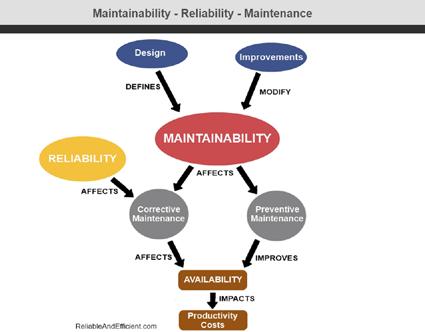
17
The Development of BIM Standards
 (Cont’d)
Clarabel Versace
(Cont’d)
Clarabel Versace
BIM standards have been in place for a couple of years now. Different countries have developed their own standards, however the UK back in 2011 triggered the idea to move from BIM Level 2 UKStandard to international standards. This pushed the industry to opt for international standards and norms considering BIM globalisation. The figure below shows the timeline of how BIM standards developed back in 2010 till 2021.
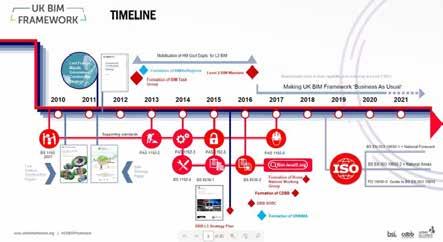
In the early years, the UK standards were mainly BS 1192:2007 and the PAS1192-2 for BIM Level 2. In 2019 these were then developed to international standards. To date the ISO19650 standard is an international standard and is used to manage information for the whole lifecycle of a project using BIM. It is based on the UK standards BS1192 and has five parts. These are:
BS EN ISO 19650-1:
Organization and digitization of information about buildings and civil engineering works, including building information modelling -- Information management using building information modelling: Concepts and principles.


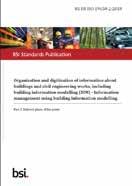
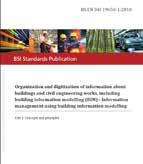
BS EN ISO 19650-2:
Organization and digitization of information about buildings and civil engineering works, including building information modelling -Information management using building information modelling: Delivery phase of the assets.
BS EN ISO 19650-3:2020:
Organization and digitization of information about buildings and civil engineering works, including building information modelling (BIM). Information management using building information modelling. Operational phase of the assets.
BS EN ISO 19650-4:2022:
Organization and digitization of information about buildings and civil engineering works, including building information modelling (BIM). Information management using building information modelling - Information exchange.
BS EN ISO 19650-5:2020:
Organization and digitization of information about buildings and civil engineering works, including building information modelling (BIM). Information management using building information modelling. Security-minded approach to information management.
18

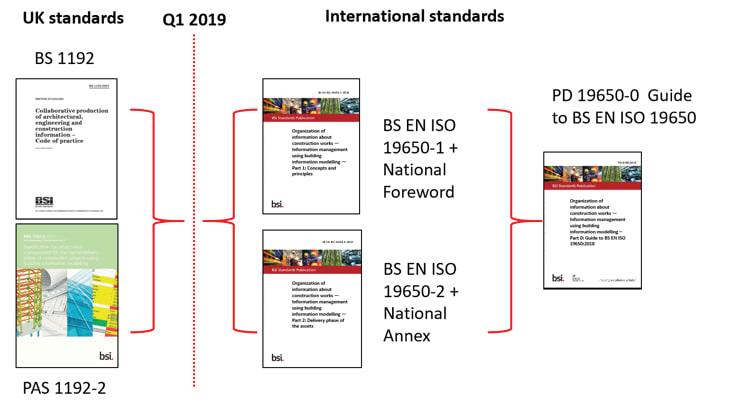
19
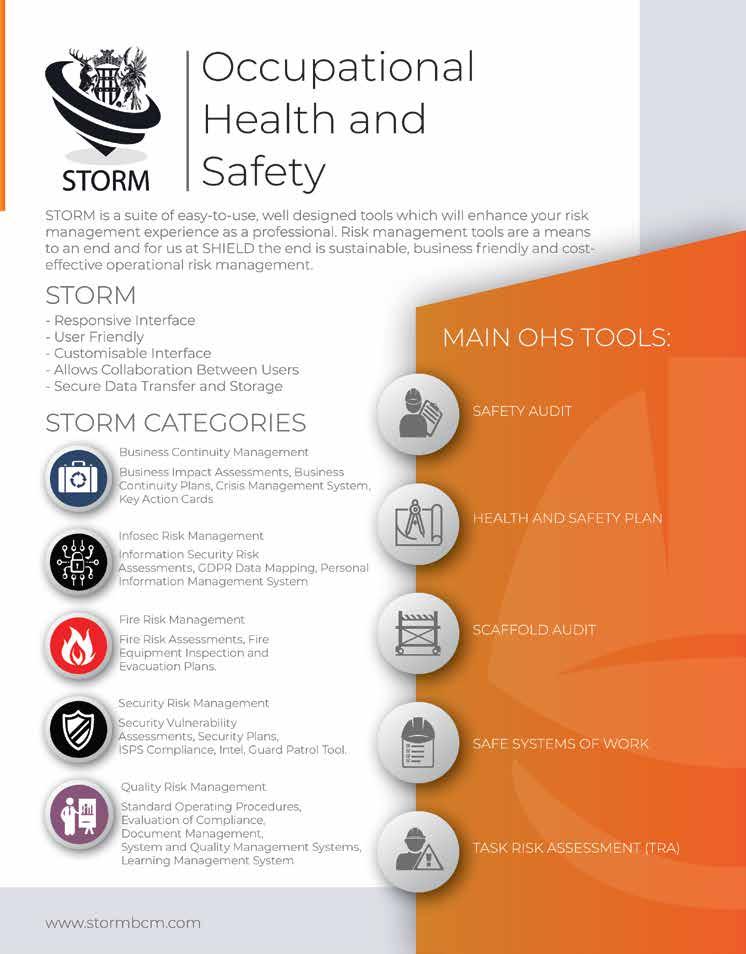
Health and Safety
SHIELD Safe Systems of Work: Safety Training
SAINT JAMES WEIGHT MANAGEMENT INSTITUTE

In the last edition, a 5-Stage approach to Safe Systems of Work (SsoW) was provided. Today we continue the series on SSoW by looking at Stage 1: Planning in more detail. In Malta, there are two levels of Planning that are essential to ensure that construction works are executed safely: (i) Level 1: Project Planning. (ii) Level 2: Safe Systems of Work. In this edition we shall thoroughly review the requirements for Level 2. Level 1 requirements shall be reviewed in the next edition as a special feature.
Safe work requires planning and competent persons responsible for designing and executing works need to ensure the following:
1. Design: the work must be designed and planned to fit into other active works, considering all the relevant and related safety aspects
2. Understanding: the design must be well understood by all those responsible for its execution, including supervisors and workers
3. Coordination: planners must coordinate between different stakeholders to ensure that the work can be started safely and on schedule
4. Mobilisation: movement of people, materials, and work equipment to site of works must done safely

5. Safety: the planned works must be always executed in a safe manner, ensuring that the planned safety measures are implemented
6. Supervision by Competent Persons: once works commence, it is vitally important that the appointed safety competent person regularly supervises the workers to ensure that OHS measures are fully and effectively implemented.
above can be achieved through a Safe Works Method Statement and Risk Assessment [SWMSRA] process. It combines a thorough method statement drawn up by (a) technically competent person(s) with a legally-compliant OHS risk assessment process. In this manner, the SWMSRA ensures that the requirements stipulated above are effectively implemented in a single process, enabling all the project stakeholders to implement a SSoW as required by Maltese OHS regulations.
It is worth noting that a general risk assessment is likely to be insufficient at law, specifically under S.L.424.18; 10 [Risk Assessments]. A SWMSRA should always be preferred when works involve complex or dangerous tasks and must be the preferred option when the nature of works involves intrinsic high risk.
John Schembri,
The best available technique not entailing excessive cost [BATNEEC] that guarantees requirements 1 to 6
21
Figure 1: All work should be Planned through a SSoW
MSc.[Sy&RM]; L’cstr; PgC.[OHS]; P’mth; SIRM; CBCI
Women in Construction - diversity & inclusion Building Trust
Michael Spiteri

The Oxford dictionary defines trust in a variety of ways: to believe that someone is good, honest,sincere, credible, dependable to do the right thing and so on. However, in terms of workplace health and safety, it is sometimes perplexing. "Good relationships are built on trust" is another example of trust. And of course, what is worksite safety if not an interconnected network of relationships. Additionally, good work relationships are connected to increase profit and improve productivity.

Although trust has been discussed in many disciplines for several decades, it was not before1980s that it started to gain interest in management (Kadefors 2004; Romahn and Hartman 1999).

Employees are more willing to share safety concerns, cooperate, report unsafe practices and speak out about possible hazards when they feel trusted by both their employers and co-workers.
Have you, as a contractor, asked your workers how much they trust you when it comes to your attitudes and behaviour about safety-related matters? Do you understanding how your workers collaborate and behave?
22
Trust creates a safe environment where open dialogue is favoured meaning any incidents or issues can be identified, discussed and resolved, free from judgement or fear of repercussions. As (Khalfan et al. 2007) stated: “there needs to be a cultural change, a move from a ‘blame culture’ to a ‘problem-solving culture’.”
Is there a good communication between the working teams? Are you committed to provide resources and effective communication, coupled with an open and ‘no blame’ environment in which problems are resolved through consultation and the use of shared knowledge and learning? Does a trust ‘gap’ exists?
Lack of Trust
Trust has been determined by many studies as an excellent determinant to successful construction projects and, thus, should be included within the discipline of project management (Atkinson et al. 2006; Lendra and Andi 2006). On the other hand, distrust can destroy the work culture values and can also have negative consequences on absenteeism rates, turnover, safety incident rates, subcontracting quality and productivity. Instead of encouraging open and honest dialogue about safety, which leads to ongoing improvement, it isolates people and stifles participation. A PWC 2022 series survey study shows that 71% of employees will leave their employer if they lose their trust in them.
Trust is a two-way street—and so is employee feedback. I understand that every contractor wants a safe and a healthy environment but unfortunately, some contractors do not know where they stand in terms of health and safety. Why? There isn’t a culture of trust and so employees do not bring up safety issues or grant their feedback.
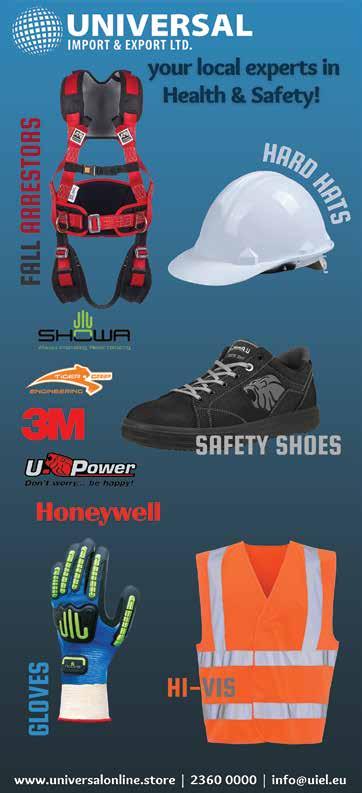
Some simply forget, while others prefer not to because they are afraid of the consequences of reporting harmful activities. Other contractors will blame the individual rather than investigating all of the elements that contributed to the accident or near miss. Instead of attempting to learn and develop from an accident, some contractors go on a witch hunt to determine who is to blame. Another reason workers do not report is because they do not trust anything will be done about it. This means that they regard the feedback process as a pointless effort.
There are numerous ways to build trust within your workforce, including but not limited to the following: leading by example with honesty and integrity, communicating openly and listening to workforce input, respecting and appreciating workers contributions, setting achievable goals and providing necessary resources, resolving conflicts promptly and impartially, collaborating and involving work-team in decision-making, supporting their growth and work-life balance, celebrating successes and learning from failures.
23
It is a system that is intended to allow the MCCM to welcome members from across the Construction Management community
THE BALANCE OF SUSTAINABLE ADAPTATION & CONSERVATION:
 Perit Charlene Jo Darmanin AP Valletta
Perit Charlene Jo Darmanin AP Valletta

The refurbishment and restoration of The Phoenicia Hotel stemmed from the need of a sustainable business model for the hotel and extensive grounds. A masterplan was prepared by AP Valletta in 2005, favouring a coordinated approach for restoration and intervention to maximise the possibilities of integrating new requirements and facilities, while improving the legibility of the historic property. Work commenced on site in 2015, with the restoration of the hotel, the construction of a new Health Club & Spa and the refurbishment of the pool.

24
Photo Credit: Julian Vassallo
THE PHOENICIA HOTEL
(PART 1)
The Phoenicia Hotel, and the surrounding grounds, are immersed in a site of rich historical development, enveloping and defining the boundary shape. The hotel construction was initial by Lady Strickland in 1935, under the design of Arch. Col. Lt. William Bryce Binnie. Designed for a cosmopolitan clientele and intended to provide accommodation for the wives of the officers of the Mediterranean Fleet, the hotel was constructed in an Art Deco Style. Construction commenced in 1938 and, although progress was decelerated by the outbreak of World War II, was completed by 1948.
One major design consideration for Binnie was to ‘embody the spirit of Malta’ in the hotel, exhibiting numerous references to Malta’s monumental heritage. The conservation exercise aimed to revive the original design legibility of the building, guided by an understanding of the inherent values attached to the monument and surrounding context. The extension of the fourth floor, an addition in the 90s, was re-worked as part of the conservation exercise, to diminish the impact on the skyline and restore the verticality of the iconic stairwells and turrets, typical of Binnie’s design. Derelict structures were removed to reduce built-up areas, with all interventions on the hotel envelope ensuring that the angular volumes of the historical building were maintained, preserving its formal relation with the fortifications. The extension was capped off with the creation of a cornice, unifying the additions and reintroducing the grandeur that the building symbolizes. The cornice, immediately legible as a contemporary intervention, serves as a drip detail to ensure that water surface run-off is thrown off the restored façade, reducing the requirement of maintenance by preventing the occurrence of water streaks.
The restoration of the hotel included the refurbishment of several systems, including the replacement of architectural lighting with LED fittings, the replacement of all mechanical ventilation components, the installation of double glazing and upgrading of the kitchen, reducing the overall environmental impact of the hotel operations and ensuring a sustainable model for the monument’s continual preservation. The integrated restoration approach ensured that heritage and architectural values of the hotel were preserved while acting as a catalyst for the new interventions. This combined approach restored the Phoenicia Hotel to its grandeur as an architectural landmark, both subtle and timeless.

25
Photo Credit: Julian Vassallo
The Importance of Health and Safety in all phases of Construction

The H&S breaches drawn in more than half of the conclusion of the recent magisterial inquiry takes us back to basics in the management of construction projects.
Each project needs to have a H&S practitioner to carry out:
1. Consultation and collaboration with competent skilled workers and all key stakeholders.
2. Consistency in Industry Practices, there is no place for shortcuts.
3. Esurance that instructions given are thoroughly understood and endorsed by the responsible people.
4. Physical presence on site to set the pace and maintain discipline.
H&S together with other disciplines in this industry is needed in every phase of each construction project to protect lives and act as a link with all those involved.
Josette Cutajar (H&S Advisor)
To persuade the general public that the building industry must take H&S seriously, we still have ways to go. I would ask for example, what authority for instance, does OHSA have to take enforcement action against architects or designers who fail to implement safety measures? With more projects being performed, OHSA must collaborate with these stakeholders to create and advance better standards ideally at the planning stage, to meet the site-specific safety requirements in such a way that will not threaten the lives of the workers and the public. We all agree on the need for appropriate regulations, effective enforcement and the application of sanctions and punishments to erring offenders in this sector.
Michael Spiteri (H&S Advisor and professional)
Health and Safety has always been important. In so far as industry wide practice, the magisterial enquiry served to remind us of the necessary steps required to work safely and the unfortunate consequences when these are disregarded.
Jonathan Buttigieg (Company CEO)

The Health and Safety aspects within the context of the building and construction industry should be paramount in terms of priority as this industry is well known for its complexities and risks. The issue is that many property development projects tend not to prioritize the implications of an unplanned health and safety ‘regime’ at the very early stages of a development’s expected life cycle. Most often project sponsors realize this when it is too late, and the impact would have caused disruption to their time and cost elements amongst other aspects including their reputation.
The planning of the Health and Safety strategies are very important to be included at the very early stages including the conceptual stages. Developers and Design Consultants need to look at H&S aspects thoroughly including but not limited to the geographical location of the site, the intended timeline of the construction cycle by taking into consideration the weather conditions (seasonality) and most important the immediate environment (habitat). All these aspects would surely trigger the areas relative to the level of risks and mitigation thereof that would assist towards the shaping up of budgets and time elements avoiding surprises later. The project elements that of access to the site, access to the town or village, its surroundings, the use of adjoining property, the geotechnical conditions, utilities infrastructure including storm water etc. etc.…..all these would determine what health and safety measures would need to adopt including constraints that might trigger re-designing of specific element to the planned development as to ensure that when the said development is being built it takes into consideration its ‘temporary’ nature is always fit for purpose including adequate budgets and the right level of competent persons are engaged.
Therefore, the integration of health and safety strategies and plans at design stages is ‘key’ towards the successful execution of any development.
Karl Azzopardi (Chartered Project Manager)
One pressing concern I've consistently encountered on construction sites in Malta pertains to the alarming lack of coordination between clients and contractors in matters of health and safety. This issue becomes particularly pronounced on sites involving multiple trades, where, all too often, workers are left to fend for themselves with minimal oversight. Shockingly, there are instances where contractors neglect to certify equipment unless explicitly prompted by the client. Such negligence should be an inherent part of the operational culture.
It is disheartening to observe that, in many cases, tangible action on health and safety is only initiated when a serious accident forces the intervention of regulatory authorities.
It is imperative that the role of the construction project manager extends beyond mere project execution. Instead, they should proactively champion and enforce comprehensive health and safety procedures, ensuring that all relevant standards are rigorously met before any potential accident disrupts the project. Not only does this safeguard the well-being of workers, but it also mitigates the adverse impacts on project timelines and costs, thereby fostering a culture of safety that should be non-negotiable in the construction industry.
Fabrizio Gerada (Chartered Project Manager)
Are we still in the “UWEJJA” culture?
Health and Safety (H&S) in all construction phases are of paramount importance – this we cannot deny! With an island such as Malta, experiencing another booming phase within the construction industry, safeguarding workers and the public is critical. Comprehensive planning and stringent adherence to safety regulations ensure that potential risks are identified and managed effectively. Maintaining a secure working environment not only protects lives, but also prevents costly delays.
Regrettably, I personally continue to encounter numerous instances of non-compliance and deviations from H&S regulations and plans. It's astonishing that even in the year 2023, my colleagues and I still come across personnel in the construction industry who lack a basic understanding of H&S legal obligations. Not only, but I still encounter the odd guy replying “uwejja” to my direction or instructions to safeguard his own health in the first place. Furthermore, there are still contractors who fail to prioritize H&S, mistakenly believing it to be a costly endeavour, without realizing that post-incident costs are even higher. In Malta, emphasizing the importance of health and safety in construction goes beyond mere legal obligations; it stands as a fundamental pillar of sustainable development, benefitting both the workforce and the nation as a whole. Therefore, as Construction Project Managers, it is imperative for us to lead by example and advocate strict adherence to H&S regulations.
Cachia
Health and Safety in the construction workplace should be considered a necessity and not seen as a burden by the employees and employers alike. Having a safe and comfortable working site encourages a cleaner and happier working environment for all parties which will ultimately result to less delays, more productivity, and a more satisfied end client.
Lara Lewis (Company Director)
Health and safety processes play a vital role in minimising the number of risks on a construction site and, as such, they should be implemented from the start and throughout with no excuses. It is key to introduce a lead in/planning period to site commencement and set the standard from inception, and to get all contractors on board. This starts with site welfare, tidy, professional and secure site perimeters to protect passer-by’s and the right education via site inductions and briefings. This continues through all the stages with every aspect of the project being planned with H&S at the forefront and a zero tolerance attitude towards noncompliance.
This has been the approach to all my projects in Malta to date and it works. It’s all in the planning and should be non-negotiable.
When this is carried out, contractors coming to site will know they have to meet a certain standard as soon as they enter!. A safe environment provides a platform were no man hours are lost and provide an efficient workspace for all to hit key milestones. A misplace conception is that H&S is expensive, but beyond keeping our people safe, it also makes business sense.
Article 4. of the OHSA Act XXVII/2000 is a declared principle andis clear and unequivocal – occupational health and safety is a matter of public interest; no ifs, no buts. All projects necessarily impact on multiple stakeholders, and the following elements are indispensable to a safe project, successfully executed.

1. The entire stakeholder chain affected by planned work, directly or indirectly, must be identified.
2. Reducing Risk to Protect People (R2P2) techniques should be applied to ensure that all stakeholders are protected, from Design and Planning Stages through to Execution.
3. Safe Systems of Work must reduce risks from identified and known hazards down to levels that are reasonably practicable.
Anything less than the above and safety will invariably fail at some point.
John Schembri (H&S Advisor and Professional)
Lewis Blake (Chartered Project Manager)
Andrei
(Chartered Project Manager)
Document F Consultation
A much-deserved overhaul towards energy efficient buildings in Malta
 Perit Luca Caruso MPhil Candidate, Well Ap, EDGE Expert
Perit Luca Caruso MPhil Candidate, Well Ap, EDGE Expert

Recently I submitted my comments related to the long-awaited consultation issued by the BCA on the Minimum Energy Performance Requirements in Buildings. Indeed LN 47/2018 marked the passage from voluntary (guide F) to mandatory application of the requirements as a form of energy code and assess the quality of buildings. My first reaction is definitely positive because the Authority is setting the threshold of quality below which it would be unacceptable to have new and retrofitted buildings. However, in my opinion several critical aspects are yet to be resolved.
A new National Calculation Method should be accompanied by an update of the software used for Energy Performance Certification (EPC). Malta has a cooling-dominated climate and the hot and humid conditions can only be properly assessed with transient analysis and not steady state calculation methods: we need to mainstream dynamic hygro-thermal building energy simulations (as requested ISO 52000 package). Moreover, the provision of minimum thermal conductivity
values will lead to partial assessments because they are not including the effects of moisture diffusion across the envelope driven by water vapor pressure. In view of an increase in the rate of indoor insulation installations, and the related risk of interstitial condensation, it would be ideal to introduce the simplified “the Glaser method”, or more advanced ones to expand the number of verifications needed when designing the building opaque façade.
A landmark change would be to require, at permit stage, the submission of a complete energy assessment for both envelope and technical systems as part of the mandatory documentation and evidence to obtain the approval of planning applications. Energy efficiency is a must and not a nice to have.
To aid end users looking for efficient buildings, it should be introduced a new rating system based on classes A, B,C etc (similar to the principles of eco-design of electronics) reflecting the current status of the energy performance of the built environment. This is especially important for building renovations because any incentive (taxation, grant,etc) could be tailor made in order to facilitate the leap from the least energy efficient to higher efficiencies.
Stable indoor temperature, due to insulation, must be supported by Indoor Air Quality strategies for example by recommending building materials with low Volatile Organic Compounds (VOC) emissions because the most polluted environment is indoor not outdoors. In this case encouraging the use of mechanical air changes will sensibly improve the perceived air quality and avoid surface condensation and mould.
28
Interior Design
Selecting your Interior Designer
Vera Sant Fournier
In the world of interior design, where every space is a canvas waiting to be transformed, the choice of the right designer is nothing short of pivotal. Interior design is not merely a skill that can be thought ; it’s a living, breathing talent that weaves dreams into the fabric of a space. In this article, we will delve into the essence of this talent and set guidelines to assist you, your friends, family or colleagues in choosing the right designer for their scope of work.
A talented interior designer is defined by their exceptional taste and style, which serve as the pillars of their craft. Their innate aesthetic sensibility allows them to perceive and appreciate the beauty, balance, and harmony in design, guiding their choices in colors, textures, patterns, and furnishings. This creativity is the driving force behind their ability to envision and implement unique, innovative design solutions, transforming spaces into captivating works of art. Meticulous attention to detail ensures that every aspect of a project is carefully considered, from selecting the perfect accent piece to achieving impeccable color coordination.
Beyond the technical aspects of interior design, the importance of connecting on a personal level when choosing your interior designer cannot be overstated. This relationship is the foundation upon which your design journey rests and is often a long-lasting one. When there's a genuine connection, communication flows effortlessly, trust is cultivated, and the designer can better understand your aspirations, tastes, and lifestyle. It's through this personal connection that they can transform your spaces into meaningful, functional works of art that resonate with your soul. Moreover, a strong personal connection ensures that the design process is a collaborative and enjoyable experience, where your ideas are valued, and your dreams are brought to life. The bond formed with your designer becomes a creative partnership, and their ability to empathize with your vision makes for a design journey that is not just transformative but also deeply rewarding on a personal level, resulting in spaces that truly feel like home.
Before embarking on your interior design journey, it's crucial to have a clear understanding of your personal taste and style, or at the very least, be open to collaborating with a designer who can help you define it. Your unique preferences and personality should be the guiding force behind your project, as they dictate the choices that will resonate with you on a deeply personal level. Choosing a designer who aligns with your existing taste ensures that
your vision is understood and embraced, resulting in spaces that authentically reflect who you are. Alternatively, selecting a designer skilled in helping clients define their style can be equally transformative as you learn more about yourself. They have the ability to draw out your preferences, explore various design directions, and collaboratively craft a style that feels uniquely yours.
By following this checklist, you can make an informed decision when selecting your interior designer, ensuring that your design journey is not only visually stunning but also deeply satisfying and reflective of your unique taste and style.
1. **Define Your Vision:** - Determine your preferred interior design style and aesthetics - Clarify your project goals and priorities.
2. **Talent and Style:** - Look for designers with a well-defined taste and style that align with your visionAssess their portfolio for evidence of creativity and aesthetic sensibility.

3. **Research, Referrals and experience:** - Conduct research to identify local interior designers - Seek referrals from friends, family, or colleagues who have worked with designers.
4. **Role of the Designer:** - Understand that an interior designer serves as an interpreter of your vision - Expect them to harmonize every element in your space, from lighting to layout.

5. **Consultations:** - Schedule consultations with potential designers to discuss your project - Evaluate their ability to listen and communicate effectively.
6. **Portfolio and References:** - Request to see their portfolio and speak with past clients if possible - Gain insights into their work quality, professionalism, and adherence to deadlines.
7. **Budget Alignment:** - Ensure the designer's fees align with your budget - Seek transparency to avoid unexpected costs.
8. **Compatibility:** - Assess the personal connection with the designer - A harmonious working relationship can enhance the creative process.
9. **Personal Taste vs. Collaborative Style Definition:** - Understand your personal taste and style preferences.Decide whether you want a designer who aligns with your existing style or one who can help define it collaboratively.
10. **Long-Term Relationship:** - Recognize that the relationship with your designer may be long-lastingChoose someone who understands your evolving needs and style over time.
29
A Net Zero Economy

The Role of a Clear and Compelling Vision for the Building Industry – Part 6
David Xuereb

Malta may be embarking on a profound transformation in its construction industry. This shift towards sustainability is not only aligned with a clear national economic and social vision but also serves as a cornerstone in the transition towards a decarbonized economy. If we integrate these strategic elements, Malta's construction sector will be expected to transition towards a true and realistic driving force behind a greener, more prosperous future.
At the core of Malta's national vision is the aspiration for economic resilience. In a world where the risks of climate change are ever more apparent, the island nation recognizes the importance of diversifying its economy and reducing carbon dependencies. The transformation of the construction industry must be a pivotal component of this vision if we stand of change of achieving our ambitions.
Investing in sustainable and low-impact construction practices and technologies not only aligns with a Malta vision of economic diversification but could also position the nation as a leader in green innovation. By fostering a construction sector that pioneers green building technologies, utilizes renewable energy sources, is less dependent on physical resources and embraces efficient construction methods, Malta will not only strengthen its economy but also ensures long-term competitiveness in an evolving global marketplace.
Malta's commitment to environmental preservation and sustainability must be a key element of its national vision. The island's unique natural environment is not only a source of pride but a precious resource to be protected. The transformation of the construction industry must be an opportunity to demonstrate Malta's dedication to sustainability.
Reskilling and upskilling of all of its workforce (and this includes all qualified professionals including project and construction managers), the adoption of measurable sustainable practices and responsible/respectful construction solutions will significantly reduce carbon emissions associated with new developments and renovation works. This will align with global climate goals, promotes a decarbonized economy and links up with the
objectives of the European Green Deal. Moreover, it will showcase Malta as a responsible steward of the environment, bolstering its desired international reputation.
Malta's social vision places a strong emphasis on community well-being and inclusivity. The transformation of the construction industry is integral to creating spaces that foster social empowerment while contributing to a decarbonized economy.
A strong and rounded compelling national vision of where we all want to be in two to three decades from now, will not only transform the construction sector but will also condition professional and supportive planning processes and policies that will direct developers to support an honest transformation of a nation.
Realizing a decarbonized economy and sustainable construction industry, requires collaboration across sectors. Government entities, construction companies, architects, urban planners, construction managers, environmentalists, and communities must unite to achieve the collective vision.
Government policies that incentivize sustainable construction practices will play a pivotal role in steering the industry towards a low-carbon future. Tax incentives for green projects, streamlined permitting processes, green finance tools and rigorous sustainability standards can drive the industry towards more sustainable practices, further supporting the decarbonized economy.
Collaboration between educational institutions and the construction sector is really essential. Malta's vision must nurture a workforce skilled in cutting-edge construction technologies, sustainability practices and ethical standards.
The desired transformation of Malta's construction industry into a sustainable powerhouse is not just about building structures; it's about building a decarbonized economy and a greener, more resilient nation. This vision skilfully weaves together economic resilience, environmental stewardship, and social empowerment into a tapestry of progress where our community will thrive, all while moving towards a low-carbon future.
30
ESG and The Role of Authorities in the Construction Industry Sector
 Gabriella Borda
Gabriella Borda
The construction sector is a crucial industry that encompasses a diverse array of tasks associated with the establishment, restoration, and upkeep of structures, including but not limited to buildings, roads, and other infrastructure. Moreover, the construction industry serves as a substantial source of employment and contributes to the growth of interconnected sectors such as real estate and transportation.
ESG has become a widely recognised and discussed concept in various sectors, including construction. ESG refers to a set of criteria that important stakeholders consider when evaluating an organisation or a project and looks into performance and impact beyond just financial metrics. Governance is one of the key dimensions of the ESG framework. Good governance practices are essential in building trust, ensuring accountability, and making ethical decisions. Good practices involve identifying and managing risks and in the construction industry where risks are inherent, the integration of good governance practices is critical for maintaining high health and safety standards.

The role of regulatory entities in the construction sector is paramount for guaranteeing safety, excellence, and adherence to established regulations. These overseeing bodies have a multifaceted role, encompassing regulation, oversight, and enforcement to ensure that construction projects are safe, compliant, and contribute positively to the built environment and society as a whole
We must avoid treating ESG a mere buzzword for attention while neglecting to implement the framework comprehensively. ESG factors are interlinked and can influence one another. A holistic approach recognises these connections and avoids addressing issues in isolation. Isolating actions without considering the broader context can lead to unintended consequences. A holistic perspective encourages systemic thinking, where one recognises that changes in one part of the system can have ripple effects throughout. It’s important to anticipate these effects and plan accordingly.
It is imperative that we do not turn a blind eye to issues inherent within the construction industry’s system, which encompasses all stakeholders within the built environment, including the general public. While the ESG framework is at our disposal, what is crucial now is broad leadership that spans across domains to guide us towards effective implementation.
31
By establishing a culture of responsibility, accountability , and continuous improvement, governance contributes to the overall well-being of workers and the reduction of accidents.
Sustainability and Building Materials
 Chantal Stagno Navarra MCIOB
Chantal Stagno Navarra MCIOB

The role and challenges of project managers in Sustainable Construction
Given that project managers have an influential role within a project, we are in a position to guide our clients towards change – a positive change that can help combat climate change. This can be achieved when the three pillars of sustainability are considered. These are: Social, Environmental and Economical Sustainability.
Working to improve efficiencies on projects by implementing new initiatives that will save time and money and prevent waste is an example of strategic project management. By doing so, professionals working in this field can help build faster and smarter.
As project managers we have the opportunity to reduce both the causes and consequences of climate change. For example, a cause is the use of unsustainable materials such as concrete, and the consequence is unnecessarily high CO2 emissions.
However, our role is not as simple and we face multiple
challenges at all levels of a project. These include convincing a client to opt for different building materials that are greener but in general more expensive, to finding skilled workers that know how to handle such materials. I for one have never had the opportunity to use alternative building materials and therefore I don’t have the practical knowledge on adopting sustainable building processes.
As it stands today, we already have major issues in providing high quality buildings using the traditional methods let alone applying new standards. This challenge is also true within the professional sector; architects, designers and engineers still opt for traditional methods of designing and building. There is also inadequate public education concerning the advantages of sustainable construction because of the lack of sustainability studies, specifically on issues concerning indoor environmental condition, productiveness, and health of occupants. The
32
I believe that Malta relies heavily on traditional methods, which makes the use of advanced techniques more challenging and stressful.
lack of information of sustainable materials creates other challenges too such as programming the time required in implementing sustainable building processes and the inadequate training and education. I also believe that building policies do not encourage the application of sustainable design and the use of green technologies. We need stronger building codes to address climate change.
On a more positive note I do believe that we are heading in the right direction. More stakeholders are expressing the will to address climate change and educational material has become more available. With regards to construction the government is pushing to achieve high quality buildings and is gradually introducing training for both professionals and skilled workers within the construction industry.
As a chamber that follows the CIOB’s footsteps we prioritize education and are constantly encouraging our members to gain knowledge and skills to manage and deliver the construction process in environmentally sustainable ways.
The plan is the organisation’s roadmap to 2028 and aims to make modern professionalism in construction management widely aspired to and increasingly a reality across the industry.

The construction industry needs to operate in a way that ensures environmental impact is minimal and contributes to a sustainable future. Designing, creating, maintaining and recycling to deliver a built environment that society can live with, use and enjoy.

33
This year the CIOB has launched its new five-year plan, which focuses on quality and safety, environmental sustainability and closing the construction industry’s skills gap.
Materials
SMART WAYS TO SAFEGUARD YOUR PROPERTY
Waterproofing is a means of preventing water from entering your property. Keeping a building dry, allows for reduced humidity within and is essential for retaining a building’s structural integrity and aesthetics. It has become ever more vital to also consider the performance of waterproofing products before choosing which to use.

Weber Saint-Gobain’s Elasto Top 1 is a highly versatile, single-component, elasto-cementitious waterproofing membrane, easily applied by trowel, roller or brush. It resists cracking of over 2 mm, like the best 2 component products, since it delivers excellent flexibility even at lower temperatures. It can be left visible as is or coated with Weber Saint-Gobain Reflex-P reflective coating, for total solar reflectance.
This Class CM01P (EN 14891-2012) liquid membrane is very cost effective given that its key features include resistance to counter thrust and superior adhesion, even to damp substrates. It being fibre reinforced allows it to also be applied without a mesh for concrete protection, delivering increased durability.
It’s range of uses include the waterproofing of reservoirs, balconies, terraces, shower cubicles and swimming pools before laying ceramic tile coverings. Given its flexibility, it can be applied as a coating for the protection of plasters,
Weber Saint-Gobain’s Elasto Top 1 is Class 1 Water vapour permeable according to EN ISO 7783-1, whilst its appearance looks anthracite like when dry and can be walked on after 24 hours from final application. With 10,000 people in 60 countries, supported by almost 200 production units, Weber Saint-Gobain is the brand that cares about building better for people and the planet by offering proven solutions that deliver improved sustainability and high performance. The range includes technical solutions for the restoration of damp and saline masonry, consolidation and restoration systems for concrete structures, products for waterproofing, laying floors and providing thermal insulation (ETICS) to buildings.
www.macmedgroup.com.mt

34
screeds, micro-cracked concrete surfaces and prefabricated structures.

Discretionary Procurement Systems
Dealing with Variations in Construction Projects
Mohammed Elaida MSc (Salford), MCInstCES, MCIOB

Nearly all construction employers cannot assure that their project will unfold precisely as intended. Therefore, any deviation from the original plan is considered a "Variation". In various construction contracts (standard or customised), such a deviation is frequently referred to as a variation instruction, variation order, change order, alteration to the Employer’s Requirements, compensation event, administrative order, and so on.

Types of Variations
Variations may be defined under two main categories:
Modifications to the Scope of Work:
This classification encompasses alterations to design or method statements, adjustments to quality and/or quantity, modifications to the employer's requirements, additions, omissions, or substitutions of work elements, changes to specified material standards, shifts in the work sequence, dismantling or demolition of completed tasks, adjustments to site boundaries and access points, and the impact of external third parties or stakeholders, among other factors.
Modification to contractual terms:
In contractual agreements, the involved parties face the choice of either voiding the existing contract and drafting a new arrangement or implementing variations to the contract. These changes may include extensions of project timelines, acceleration, amendments to working conditions, responses to force majeure events, adjustments due to changes in applicable laws, and more. In certain instances, these contract modifications are documented through supplementary contract addendums.
Notifying Changes
In evident scenarios like design modifications, additions, omissions, substitutions, and the like, the employer or his representative would typically issue an official 'variation instruction'. Nonetheless, it remains the contractor's responsibility to promptly communicate any potential deviations they believe they have a right to, irrespective of whether these deviations stem from the employer, from
ambiguities in the contract documents, or from other origins. The notification shall be followed by the potential impact of the variation on the project, including the possibility of cost escalation and/or an extension of the project duration.
Fidic Red book, 2017 edition, for example, provides for ‘advance warning’ under sub-clause 8.4. The latter requires each Party to advise the other “in advance of any known or probable future events or circumstances which may:
a) adversely affect the work of the contractor’s personnel.
b) adversely affect the performance of the works when completed.

c) increase the contract price, and/or
d) delay the execution of the works or a section (if any)”
Valuation of Variations
Variations can result in additions to or deductions from the contract sum. The valuation of variations may include not just the work that the variation instruction expressly describes, but other costs that may stem from the change, such as the impact on other aspects of the works. In certain cases, variations may affect the project’s timeline and the completion date.
36
Most contracts (Standard forms or customised) allow for contract variations and set a mechanism for their valuation. Variations may be valued by:
• Agreement between the contractor and the employer.
• The cost consultant.
• A variation proposal or quotation prepared by the contractor and accepted by the employer.
• By some other methods agreed between the contractor and the employer, including the use of contract rates, new rates, daywork…etc.
with suppliers and subcontractors affected by the modifications. Delays caused by variations can impact subsequent project phases and lead to overall project delays.
Quality: Contractors might not have sufficient time to ensure that the changes are integrated properly into the project, leading to potential defects or rework down the line.
Risk: Variations introduce uncertainties and risks that were not part of the original project plan. Contractors might encounter unexpected technical challenges or encounter difficulties in sourcing specific materials required for the variations.
Design: Changes to the project scope can impact the overall design and aesthetics. This might affect the project's visual coherence and functional efficiency.
Project’s Stakeholders: Variations can affect various project stakeholders, including investors, clients, end-users, and regulatory authorities. Changes might influence their expectations, approvals, and satisfaction with the outcome.
Impact of variations on the project
Variations may have several effects on the project and its stakeholders:
Disputes and Conflicts: Conflicts between the contractor, sub-contractors and the employer can emerge at different stages, often stemming from differences in how variations are understood, their associated expenses, and potential time extensions. Disputes can result in delays, claims, and potential legal actions, affecting the relationships and reputation of all parties.
Cost and time overrun: Variations often contribute to cost overruns due to the additional materials, labour, and resources required to accommodate the changes. Variations can, also, lead to time overruns by disrupting the planned workflow and schedule. Contractors might need extra time to implement changes, revise project plans, and coordinate
Prevention of variations: While it's challenging to completely avoid variations in construction, proactive measures can be taken to minimise their occurrence. These may include:
• Conducting comprehensive site investigations and condition surveys
• Creating concise drawings, bills of quantities, and specifications that account for foreseeable scenarios
• Ensuring meticulous coordination of designs prior to the tender phase

• Establishing a clear and unambiguous contract
• Developing a broad project brief with support from stakeholders
• Integrating legislative requirements effectively into the project plan

• Thoroughly identifying potential risks
• Ensuring transparency in the contractor's pricing structure
37
A Vision for Industrial Heritage in Malta

Part 2
Prof. Ruben Paul Borg
This article draws on the invited presentation, delivered by Prof. Ruben Paul Borg at the CIOB MCCM International Built Heritage Conference, organised during November 2022. The article presents a Vision for Industrial Heritage in Malta – towards a wider appreciation of Industrial Heritage as a key element of our National Identity.

industrial heritage and to promote public access to Industrial Heritage; to organise lectures, seminars, conferences and promote training opportunities as a means of increasing the general level of education on the subject; to support publications on industrial heritage; to help preserve, conserve and restore buildings, machinery and other objects of industrial heritage importance, in-situ wherever possible; and to support research in industrial heritage and the industrial history of Malta.
The Portable Boiler
The Malta Industrial Heritage Association
The Malta Industrial Heritage Association (MIHA) is a registered voluntary organisation, to promote the conservation, appreciation and study of Malta’s Industrial Heritage. MIHA was set up in June 2022, on the initiative of Prof Robert Ghirlando and Prof Ruben Paul Borg, Chairman and Coordinator respectively of the Industrial Heritage Platform of the University of Malta, who felt the need to set up an NGO that would bring together all those with an interest in Malta’s Industrial Heritage and its preservation. Perit Vincent Cassar was elected President of MIHA. The association embraces the joint ICOMOS-TICCIH Principles for the Conservation of Industrial Heritage Sites, Structures, Areas and Landscapes (Dublin Principles). The objectives of the Association are to raise awareness among the general public regarding the importance of
MIHA embarked on its first project with the recovery of a Portable Boiler which was deposited in a scrapyard more than 40 years ago. The Boiler was set for scrap, but was recovered through the timely intervention of members of the association during August 2022. The Portable Boiler was purchased through donations of MIHA members, transported with the support of Polidano Group while Palumbo Shipyards supported through blasting and the application of protective coats of paint. The Portable Boiler is one of a number brought over by the Admiralty and employed at the Dockyard to provide low pressure steam at 15/20 psi (1 to 1.5 bar) for domestic use (washing, cooking and space heating) to ships lying in drydock. It consists of a fire-tube locomotive type boiler that was originally fired with coal but was later converted to oil. A feed-water tank placed underneath the boiler provided make-up water through a steam-driven feed-water pump attached to the boiler. It would have been attended
38
Cooridnator, Industrial Heritage Platform, University of Malta Hon. Secretary, Malta Industrial Heritage Association
“Industrial Heritage consists of sites, structures, complexes, areas and landscapes as well as the related machinery, objects or documents that provide evidence of past or ongoing industrial processes of production, the extraction of raw materials, their transformation into goods, and the related energy and transport infrastructures.”
(The Dublin Principles ICOMOS-TICCIH, 2011)
full-time by a stoker when in operation while a supply of coal and water would have been at hand. It was placed on permanent public display as a representative element of the Industrial Heritage at the University of Malta by MIHA with the support of the Rector, the Industrial Heritage Platform and the Estates, Facilities and Capital Development Directorate of the University of Malta. The Portable Boiler is intended to communicate the importance of the Industrial Heritage of the Maltese Islands.

A Future for Industrial Heritage


Industrial heritage presents in some cases archaeological evidence of past activities and technologies, as in the underground flour mills in Mistra, Xendi and other locations. In other instances, this heritage is still in use with industrialisation seen as an active process with a historical continuity, as in the undergound historic water reservoirs in use across Malta and the Reinforced Concrete Water Tower at the Public Abattoir. Besides the tangible heritage associated with industrial buildings, architecture and planning, engineering processes and technology, industrial heritage includes the intangible dimensions “embodied in the skills, memories and social life of workers and their communities”.

The vision for the Industrial Heritage of the Maltese Islands refers to the valorisation of key buildings and elements still in use, as important assets, with their conservation and continued maintenance. It also refers to the adaptive reuse of industrial heritage sites. A key element of the vision for Industrial Heritage is the creation of an Industrial Heritage Museum as a broad concept, incorporating a physical space with tangible and intangible elements, a virtual museum platform including a repository of industrial heritage including skills and memory, a network of key industrial sites in the Maltese Islands and a participatory framework to create a living platform for wide appreciation of industrial heritage.
The Industrial Heritage of the Maltese Islands defines the historical developments of the Maltese Islands over the centuries. It reflects the works and toils of our older generations and is an important part of who we are as a nation today. In this context Industrial Heritage buildings, elements and equipments merit wider appreciation and urgent action for their conservation as key elements of national identity.
39
Fiddien Reservoir
Portable Boiler
Deutsche welle radio relay station
The Eternal Plague of Adding Water to Concrete on Site
Kleaven Maniscalco

I have worked on several sites where concrete was supplied by local supplies to usually local contractors and to this very day, if the concrete is not of the desired slump, it is common practice for the concrete being delivered to have water added to it. This practice was much less common with foreign contractors who in general were much less willing of complying to such practices.
It is good to note that ideally the concrete is brought on site with the specified slump, with the specified additives and is left untouched. Adding unauthorized water on site may have a lot of adverse effects on the concrete poured on site. Adding around 50 litres of concrete to a truck of around 10 cu.m of concrete:
1. Increases the slump by circa 30mm
2. Decreases the strength of the concrete by circa 1.5MPa


3. Wastes around ¼ of a bag of cement (depending on the cement type)
4. And worse of all increases the shrinkage by circa 10%
Adding bigger volumes of water makes things even worse. If builders on site were aware of these facts, I bet no one would take the responsibility of such an action. Yet on a daily basis, the truck driver gets instructions to add water that is not authorized by the concrete supplier.
Shrinkage has a very adverse effect on the durability of the concrete. Thus, shrinkage should be controlled and kept as low as possible. Shrinkage on a large scale creates direct passages of air and water vapour to areas where steel reinforcement in the concrete section
40
is present. This causes carbonation to start happening also in that region rather than starting from the outside of the structural section and making its way inwards into the structural member. This phenomena reduces the concrete life significantly. Another way to counter this effect is to increase the reinforcement area in the structural section. This would control more the shrinkage. Having said this, it is evident that this will come at a cost, a cost which Is a direct consequence of a general ill-practice across the islands.
The decrease in strength in concrete due to the adding of extra free water in the concrete is a more known fact. What maybe is not very much know is the fact that an extra 5 litres added to a cubic metre of concrete can reduce the strength of the same concrete by circa 1.5MPa. This may be seen as small but in reality is significant because:
1. It can cause a drop in strength which may have an adverse effect on the strength of the structural members.
2. It can increase the standard deviation of the concrete results having an adverse effect on the

production of the concrete itself.
Thus, it is never wise to alter the mix on site, unless with clear instructions from the concrete supplier. Ideally concrete is poured as supplied to the site.

4141
Figure 1 – Typical concrete shrinkage crack
Different Types of Slab in Construction
Safety First, Deadlines Before?
Majeed Azam

Various types of slabs are present within the construction industry, and this article focuses on a selection of them. Slab are important elements in the construction industry to make a building of any project.
Slabs are constructed to provide flat surface, usually horizontal in building floors, roofs, bridges.
The slab may be supported by walls, columns or by beams usually cast monolithically with the slab or by the ground. There are different types of slabs based on the need and requirement, to name a few:


4. Waffle slab: Waffle slab is a reinforced concrete roof or floor containing sqaure grids with deep sides and it is also called as grid slabs. This kind of slab is majorly used at the entrance of hotels, malls, restaurants for good pictorial view and to also to install artificial lighthing.
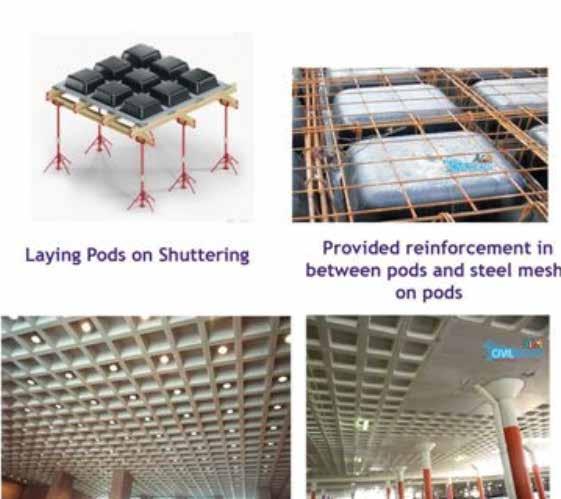
2. Conventional slab: The slab which is supported on beams and column is called conventional slab. The load is transferred to the beams then to the columns. Slabs are the horizontal elements which distributes the load to the column and then to the ground.
3. Hollow core slab: Hollow core slabs derive their name from the void or cores which run through the units. The cores can function as service ducts and significantly reduce self weight of the slabs, maximising structual efficiency. They reduces the overall cost and weight of the structure.

5. Dome Slabs: : This kind of slab is generally constructed in temples, mosques, Churches and palaces.
The dome slab is built on the conventional slab. Domes are in the semi-circle in shaped and the shuttering is done on the conventional slab in a dome shape and the concrete is filled in the shuttering forming dome shapes.
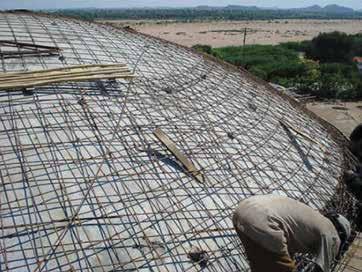
42
Here are some of the quality assurance and quality control checks carried out for slab:
Laying Pods on Shuttering
Provided reinforcement in between pods and steel mesh on pods
Filled concrete and Final finishing
Material Inspection: Check the quality of materials used (Cement, Aggregate, water and admixture) • Verify the reinforcement bars for size, grade and placement.
FormWork: Inspect the formwork for proper alingment, Stability and adequate support • Check if the releasing agent is applied to prevent sticking and other damages to the structure.
Concrete Pouring: Monitor concrete mixing to ensure correct proportion and proper consistency • Ensure proper vibaration to remove the air pockets and achieve uniform concrete distribution.

Level and Alingment: Check the level and alingment of the formwork before pouring the concrete • Use a level instructment to ensure the slab’s flatness and eveness.
Reinforcmenet placement: Verify that the reinforcement bars are placed as per the design drawings • Ensure proper cover – distance between bars and surface is maintained.
Curing: Monitor curing mehtods(water curing, curing compound) to prevent cracking and to achieve the proper strength development.
Finishing: Inspect the surface finishig to achieve the desired texture and apperance • Check for any cracks, honey combing or defects on the slab surface.
Documentation: Maintain detailed records of QAQC checks performed at various stages • Document any variation or deviation from the specification and corrective actions taken.
Safety Measures: Ensure proper safety measures for workers during all stages of the slab construction • Follow industry standard and guidleines for construction site safety.
These are the basic points , the actual QAQC process can be more comprehensive based on the project requirement and industry standards.
43
Strip Footing & Pad Foundation
Milan Zdravkovic

1. Strip Footing
Strip footing is a type of foundation that is commonly used for load-bearing walls and when the soil has a high bearing capacity. It is preferred for low- to medium-rise residential structures.
Required for External walls, Separating walls, Internal loadbearing walls.
A) Dimensions are 150mm -500mm thick depending of bearing stratum
B) Material
A1) Cast in-situ concrete

A2) pre-cast concrete
C) Concrete shall be of a mix design which is suitable for the intended use, items to be taken into account include:
A1) strength to safely transmit loads
A2) durability against chemical or frost action
D) Not recommended for ground with low bearing capacity and should be laid at a depth where the foundation can transfer the required load to good bearing stratum
E) Not intended to support building higher than 3/4storeys.The narrow trenches would need to be taken to a depth where the foundation could transfer the load to suitable stratum.
1.1 Advantages of Strip Footing
• Shallow foundations, therefore little excavation needed;

• Economically cheap due to the narrow, shallow design;
• Little to no impact on neighbouring properties;
• significantly superior to pad footings when dealing with closely spaced columns;
• Quicker in construction;
• Provides an economical alternative.
1.2 Disadvantages of Strip Footing
• Limited load carrying ability due to foundation depths and design, therefore only suited to small/medium developments;
• Not as strong as other types of foundation;
• Not ideal for framed construction;
• Weak against uplift forces, wind forces and earthquake forces;
• Weak in stratum of loose sand or gravel.
2. Pad Foundation
A) Ideal foundation for point loads from framed buildings when bearing capacity of ground is suitable a shallow depth
B) Thickness designed to transmit the load at a 45° angle through the Pad to minimise tensile stresses on the soffit of the foundation
C) Transmit the load to the bearing strata through individual foundations
D) Concrete shall be of a mix design which is suitable for the intended use, items to be taken into account include:
A1) strength to safely transmit loads
A2) durability against chemical or frost action
E) Shear reinforcement can be added to avoid punching failure
F) Not recommended for ground with low bearing capacity and should be laid at a depth where the foundation can transfer the required load to good bearing strata
G) Pad foundations are suited to a framed construction however depend of the ground type and the heavy load of the over 5 story buildings would require this usually shallow foundation to be taken deeper to better bearing stratum, thus eliminating the economic advantage of this foundation. The foundation size would have to be enlarged to cope with the high point loads.
2.1 Advantages of Pad Foundation
• Requires little excavation;
• Can be designed to accommodate tight sites;
• Economic due to control of foundation size.
2.2 Disadvantages of Pad Foundation
• Foundation size can be a very large to cope with high
• Weak against uplift forces, wind forces and earthquake
44
I CHOOSE CAREER EVENT
HOTEL PHOENICIA
Saturday the 22nd of July was the second and final day of the summer edition of the I Choose Career Fair organised by the Ministry of Education.

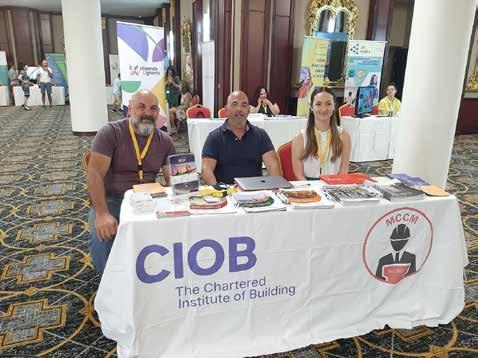

Another pleasant experience during which we had the opportunity to meet secondary school leavers, post-secondary students and their parents.
During our short speech on Friday, we had the opportunity to introduce not only career opportunities related to the construction management sector but being the only representative of the sector (apart from our friends of the Chamber of the Engineers), we highlighted other job and career prospects related to the construction industry.
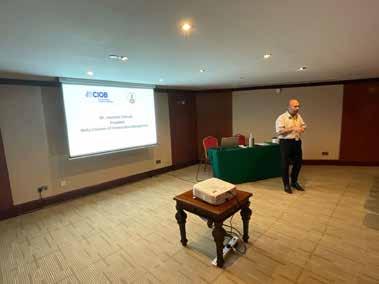
It was evident that there is still a lot of work to do when it comes to attracting the younger generation to the construction industry.
Why is our industry not attracting the younger generation?
Definitely, it is not the lack of job opportunities.As a chamber, we always believed that Education is the prime mover if we want an upscaling of the local construction industry. We must find a balance in how those already operating within the industry continue their professional development, and even more important to attract new blood. New blood that will bring new ideas of how our industry is to move to the next level.
45
I would like to take this opportunity to thank those chamber members that helped in the setting up of our stand and spent their time disseminating our message and vision to those students and parents that stopped at our stand.
Courses
CIOB ACADEMY
Master Fire Safety in Construction with the CIOB Academy Fire Safety in Construction Course
Are you a construction professional looking to boost your career with a focus on fire safety? Consider the CIOB Safety During Construction Course. This course emphasises fire safety in construction, equipping you with crucial skills to enhance safety, protect lives, and advance your career.
Fire Safety Essentials: Master fire prevention, detection, and mitigation strategies for safer construction practices. Tailored for All Professionals: Ideal for construction managers, site supervisors, architects, and newcomers to the industry, this course offers versatility to benefit everyone.
Comprehensive Curriculum: Covering fire prevention, risk assessment, emergency planning, and safety legislation, this course provides industry-standard knowledge with real-world examples.
Globally Recognised Certification: Earn a Chartered Institute of Building certification, boosting your professional credibility and commitment to top-tier fire safety standards.
Networking and Career Growth: Connect with industry professionals, experts, and potential employers to expand your career within your organisation or explore new opportunities.
Invest in Your Future: Stay competitive in the evolving construction industry. The CIOB Fire Safety Course enhances your skills, knowledge, and impact. Book now for career growth and project safety.
Exclusive Offer for Malta Chamber of Construction Management Members: Use code "MCCM10" for a 10% discount.
Course Date: September 28th
Visit our website for details and booking.
IDEA COURSE
People who aim to be Qualified Construction Project Managers can enrol in these different courses designed to help you reach your next career milestone!
A Certificate in Site Management (MQF 5) is for those with relevant experience but with an O-level standard of education. The course covers construction project processes, legal aspects, management skills, health and safety legislation, and environmental and sustainability issues.
The B.Sc. in Construction Project Management
(Top-Up) (MQF 6) is ideal for those with a higher diploma (MQF 5) in a subject related to the construction industry. Those who have a Certificate or Diploma may opt to exit this course at an earlier stage and obtain a Level 6 Award in Construction Project Management.
The B.Sc. in Quantity Surveying (MQF 6) is designed to equip students with the necessary knowledge in cost planning, procurement processes and the management of construction projects. As the demand for this skill increases, there is a wide range of job opportunities.
The M.Sc. in Construction Management (MQF 7) is for construction and civil engineering professionals who would like to advance in their careers with the necessary tools and the latest industry knowledge.
Find out more here: mt.ideaeducation.com
SHIELD CONSULTANTS LTD
Safe Systems Of Work – Half Day Course
Safe Systems of Work [SSoW] are a mandatory requirement under the OHS Laws of Malta, under OHSA Act XXVII/2000 and related Subsidiary Legislation. Professionals in all fields of activity need to understand how SSoW and their respective roles in ensuring that work of all kind is planned effectively and safely executed. This course is designed to provide an effective introduction into SSoW for professionals across the construction industry, covering the five elements of a SSoW as SHIELD
Professional Practices:
• Planning
• Responsibilities
• HAZID and RA
• Implementation of Controls
• Risk Management and Emergency Preparedness
This Course is for: OHS professionals; Site Foremen; Planners; Architects; Site Supervisors; STOs
Venue: SHIELD Consultants Ltd and/or online
Duration: 4hrs
46
Education & Development CPDS
Health and Safety Induction Video
Designed to be used by any organisation to reinforce their existing welcome training; this course provides essential compliance knowledge in fire safety; first aid procedures; manual handling; and slips and trips. We also include open-ended advice on fire assembly points and emergency contact details; so that you can properly inform any new employee on the health and safety procedures within your business.
https://cpduk.co.uk/courses/business-safety-systems-health-and-safety-induction-video
Health and Safety Responsibilities for Directors
In this short program we outline the legal responsibilities for Directors and other managers concerning Health and Safety practice; and cover the penalty framework surrounding breaches in health and safety.
https://cpduk.co.uk/courses/business-safety-systems-health-and-safety-responsibilities-fordirectors

Carbon Challenges in the Built Environment
This webinar focuses on the carbon journey with regards to achieving carbon neutrality. It places emphasis on the various options available for external verification and the value associated with different approaches. It aims to guide participants on how to undertake the carbon journey in a structured manner, while highlighting the potential inclusion of high-value offsets as part of the overall strategy.
https://www.ciobacademy.org/product/carbon-challenges-in-the-built-environment/
47
Opinions
H&S in Construction -all phases- in view of the recent magisterial enquiry findings, how important is it?
H&S exists on any site of work, irrespective of sector, be it construction or even administration. An HSP identifies risks and hazards on the workplace but does not police all the works. Risk is the only facet that spans all phases of a build. Risk cannot be avoided, but it can be assessed and managed. H&S and proper practices, should be the responsibility of everybody on a site, stemming from training, education, and general change in mentality.
Mark Spiteri (Perit)
The country is facing difficulty to change the culture where H&S is concerned. The influx of foreign workers employed in construction sector, due to shortage from local labour force, both local & foreign workers need to be in a possession of a H&S Card in this field (BICC). More Site inspections from H&S officers.
Robert Abela (Site Manager)
Prioritising H & S is my standard, it relieves mental stress for me. It evidently shows that unfortunately we have people in the sector who due to lack. of education, experience and knowledge, picture H & S as additional costs or waste of time.
The authorities are not doing their utmost to change this mentality.
Tancred Zarb (Manager)
The industry is under severe criticism for its several shortfalls, in particular to H&S. The apathy and indifference from most of the construction developers/contractors/workers to adapt and opt for a cultural shift towards a more safer work environment at any phase of a project, is blatantly evident and needs a drastic change in the way enforcement is being tackled, the employment of skilled labourers, compulsory training in H&S, and others.
Matthew Camilleri (Project Manager)
I was involved in the construction industry for the past 23 years however in Malta I have seen only minimal changes in connection with H&S. The industry requires more humanresources to enforce rapidly all points mentioned in the method statement and according to H&S report. These should apply to all construction industry including road works. Lack of education, enforcement & implementation will continue to lead for accidents & fatalities.
Adrian Schembri (Quantity Surveyor)
Not to have any injuries on site, especially fatal once. It is important safety around the construction site. Also, it is needed to protect third parties passing by.
The important thing to prove that health and safety measures were taken. People follows and apply the regulations according to the law in health and safety.
Yasemin Aktas (Civil Engineer)
I have personally experienced great improvements in the industry between 2005 and 2015, especially with large scale projects such as the Valletta City Gate and Tigne Point. It is very disappointing, from a technical point of view, that the attitude towards Health & Safety in our construction industry has deteriorated over the past few years to alarming levels and with the tragic consequences that we all know. I however believe that we still have the knowledge and the tools to change and improve. We simply have to!
Eamon Grixti (Chartered Project Manager)
48
We should aim to make H&S in all stages of a project as a positive competitive sport. Starting from designing safety features from concept to implementing them on site can not only improve H&S performance but also construction efficiency, staff retention and morale, public support for the industry and quality.
Nicholas Vassallo (Head of Business Strategy)
Occupational health and safety are paramount in construction. From planning to completion, safeguarding workers is essential. Prioritizing safety minimizes accidents, ensures compliance with regulations, and promotes a culture of well-being. It is a shared responsibility, protecting lives, and enhancing project success.
Arife Kizoglu (Civil Engineer)
Through my 25 years’ experience as Construction Project Manager, although locally, H&S has made a leap forward, unfortunately, it is still mostly considered during the implementation phase of the project.
We as Construction Project Managers are uniquely positioned to integrate Occupational health and safety into all the aspects of the design and implementation phases of the project. The successful execution of our projects normally depends on the adherence to the methodologies applied around monitoring and controlling process. So, the best way forward is the actual ‘Integration of safety’ into these processes.
Mario Falzon (Construction Project Manager)
Ensuring construction site safety is paramount, as demonstrated by the tragic loss of Jean Paul Sofia. This incident highlights the urgent need for robust safety protocols. I propose enshrining clear, layered safety measures in legislation, overseen by an impartial third-party organisation. From structural planning to completion, mandatory rigorous checks and policing should be conducted and signed off at key stages throughout the project’s lifecycle, culminating in a final building control certificate. All construction sites, regardless of size, must adhere to strict safety standards, including temporary works / method statements and risk assessments to be verified by Structural Engineers and Architects at preconstruction stage.
Adam Eyre (Chartered Project Manager)
Health and safety in construction is more than just a legal requirement, it plays a fundamental role in protecting the well-being and lives of workers. Construction sites are hazardous by nature, with several potential risks and dangers lurking around every corner. Construction workers face unique challenges every day, thus employers shall offer continuous training and provide necessary safety equipment whilst the authorities should keep the control and educate. ‘Education is the most powerful weapon which you can use to change the world.’
Stephen Casha (Site Manager)
The first rule any person managing works in construction must aim to abide by, if nothing else, is adherence to safety measures. If not because of the law, because if the duty of care. This is a fine line between law and morals - where a reasonable standard of care in construction sites should exist whatever law we amend, establish, or abolish. This is the backbone not only of every well managed building site, but of a healthy, progressive society.
Maria McKenna (Perit)
49
Events 2023
MALTA CHAMBER OF CONSTRUCTION MANAGEMENT


Events in programme for the coming months
11th October Quality in the Construction of Reinforced Concrete Structures

Part 1 by Rueben Paul Borg
24th October Quality in the Construction of Reinforced Concrete Structures
Part 2 by Rueben Paul Borg
14th November Rain Water Management - Joseph Abela (WSC)
21st November Health & Safety (Hoisting and Rigging) by Michael Spiteri
28th November CPM Professional Indemnity Insurance Presentation by MIB





2nd December Chamber AGM and Presentations


Malta Chamber of Construction Management would like to thank its Partners





50
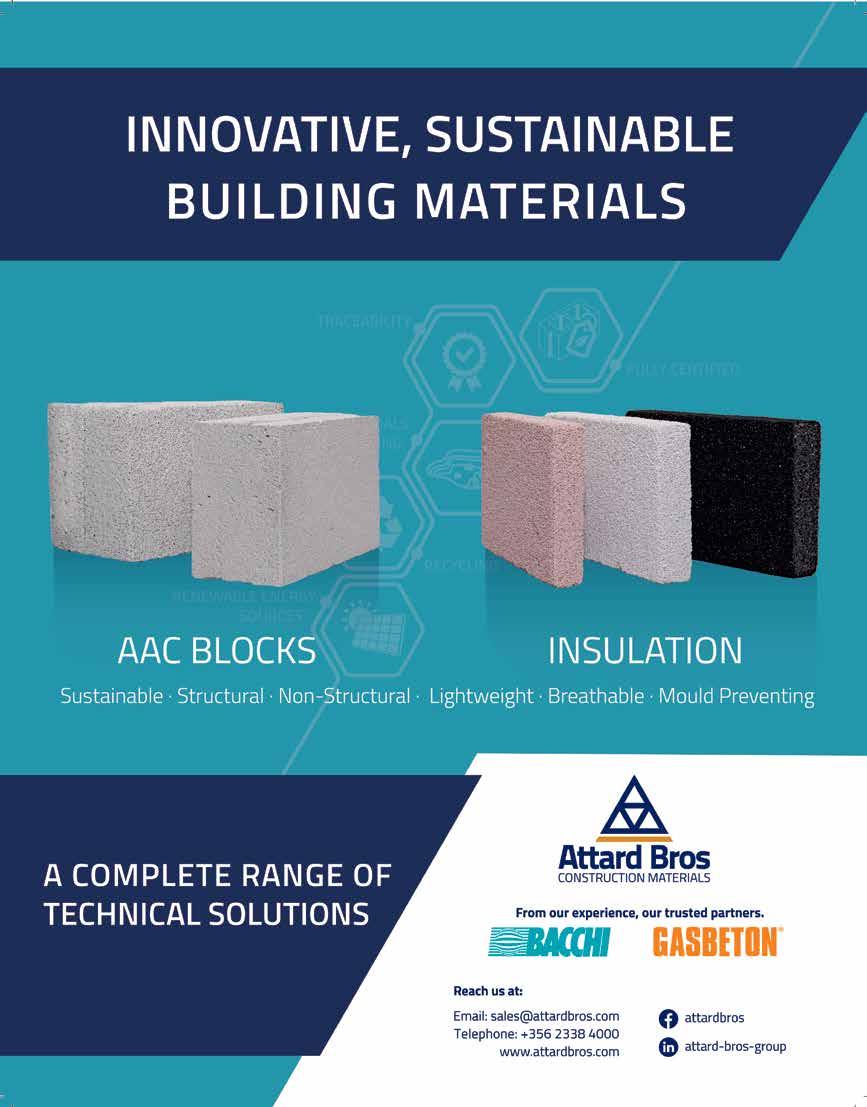






















 Cihan Sahin
Cihan Sahin
 Mr. Ed Howell
Mr. Ed Howell






 Andrei Cachia MCIOB
Andrei Cachia MCIOB











 Karl Attard
Karl Attard


 (Cont’d)
Clarabel Versace
(Cont’d)
Clarabel Versace














 Perit Charlene Jo Darmanin AP Valletta
Perit Charlene Jo Darmanin AP Valletta





 Perit Luca Caruso MPhil Candidate, Well Ap, EDGE Expert
Perit Luca Caruso MPhil Candidate, Well Ap, EDGE Expert





 Gabriella Borda
Gabriella Borda

 Chantal Stagno Navarra MCIOB
Chantal Stagno Navarra MCIOB

















































